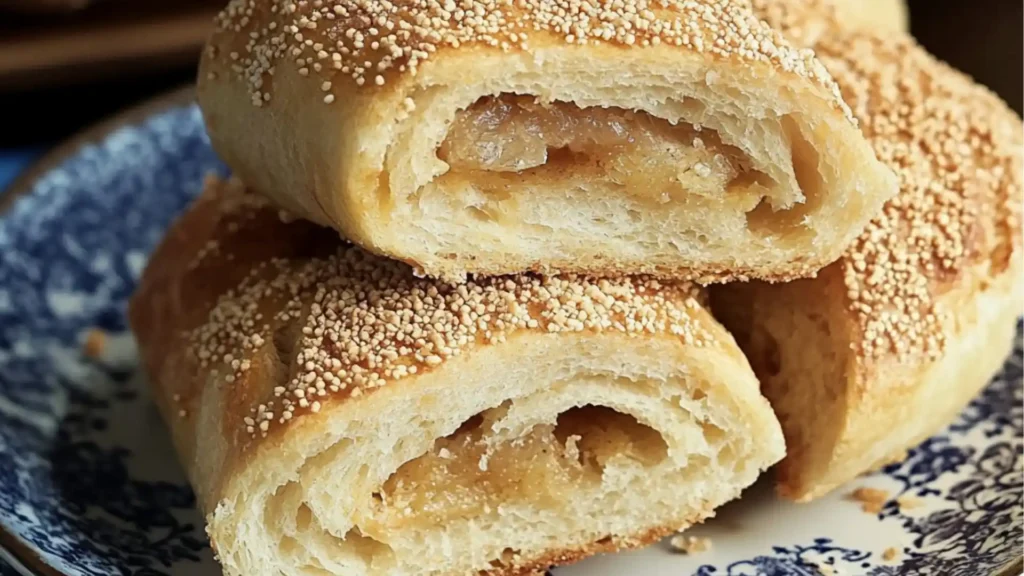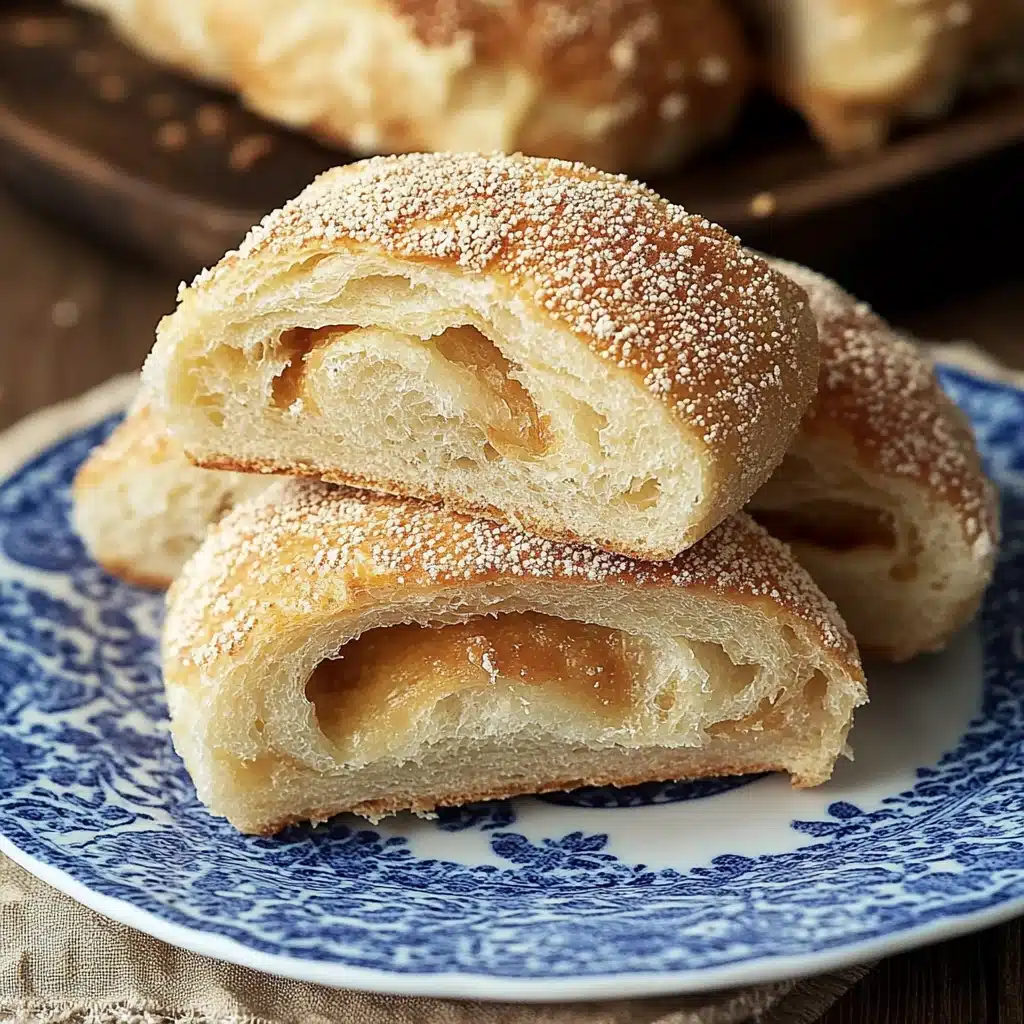If you’re looking for the ultimate nostalgic treat from the Philippines, Filipino Spanish Bread is a must-try. With its soft, fluffy dough rolled around a sweet, buttery filling and dusted in breadcrumbs, this bread is a beloved part of Filipino bread recipes Philippines culture.
Commonly found in neighborhood bakeries across the country, this Spanish bread Filipino recipe is a staple merienda (snack) that both kids and adults look forward to pairing with a warm drink. Despite its name, it’s a traditional Filipino sweet bread through and through—with its own identity separate from Spanish or European breads.
Whether you’re craving a bite of home or are new to Filipino coconut bread treats, this recipe is your gateway to baking success.
Table of Contents
What Is Filipino Spanish Bread? Origins and Tradition
Despite being called Spanish Bread, this delicacy is uniquely Filipino. It’s believed that the Spanish influence during the colonial era inspired the name and possibly the baking style, but make no mistake—this is a Filipino bread recipe that has evolved independently and is part of the everyday Filipino bakery lineup.
The bread is soft and pillowy like a pandesal, but it’s rolled into a log and filled with a rich buttery-sugar filling. In some versions, especially in provincial areas, Filipino coconut bread variations add desiccated coconut to the filling for extra flavor.
If you’re familiar with Senorita bread recipe Filipino style, you’ll notice they are similar in appearance but differ slightly in texture and sweetness.
Why This Spanish Bread Filipino Recipe Is So Loved
There’s something irresistible about the combination of tender bread, sweet filling, and toasted breadcrumbs. Here’s why it’s so beloved:
- Soft and fluffy texture: The dough is similar to pandesal—light, airy, and slightly sweet.
- Rich filling: Made from butter, brown sugar, and breadcrumbs, it melts into the bread as it bakes.
- Perfectly portable: Enjoy it for breakfast, merienda, or dessert.
- Freezer-friendly: Bake a batch and store for quick, homemade treats later.
- Versatile: Make it traditional or add coconut, ube, or cheese twists.
If you love exploring easy Filipino recipes, this is a great place to start. It’s beginner-friendly, family-approved, and deeply comforting.
Ingredients You’ll Need for Filipino Coconut Bread Delight
This recipe makes about 16 pieces of Spanish Bread. Here’s what you’ll need for both the dough and the filling.
For the Dough:
- 3 ½ cups all-purpose flour
- 1 ¼ cup warm milk
- 1 egg
- ¼ cup sugar
- ¼ cup softened butter
- 1 tsp salt
- 2 ¼ tsp instant dry yeast (1 packet)
For the Filling:
- ½ cup softened butter
- ½ cup brown sugar
- ½ cup breadcrumbs
- 1 tsp vanilla extract (optional)
- ¼ cup desiccated coconut (optional for Filipino coconut bread variation)
For Coating:
- Extra breadcrumbs for rolling
This simple list keeps things authentic while allowing room to experiment with coconut, cheese, or even chocolate filling if you wish.
Essential Tools for Filipino Bread Recipes Philippines Style
To make the perfect Spanish Bread, it’s helpful to have the right tools:
- Mixing bowls
- Dough scraper
- Stand mixer with dough hook (optional)
- Rolling pin
- Measuring cups and spoons
- Baking sheet
- Parchment paper or silicone mat
- Clean kitchen towel for proofing
These tools will make your baking easier, but this recipe is flexible enough to do entirely by hand if needed.
How to Make Filipino Spanish Bread – Step-by-Step Instructions
Step 1: Activate the Yeast
In a bowl, combine warm milk, sugar, and yeast. Let it sit for 5–10 minutes until frothy. This step ensures your yeast is alive and ready to rise.
Step 2: Make the Dough
In a large bowl or stand mixer, combine the flour and salt. Add the yeast mixture, egg, and softened butter. Knead until a smooth, elastic dough forms—about 8–10 minutes. If it’s sticky, add a little flour at a time.
Step 3: First Rise
Cover the dough and let it rise in a warm area for about 1 hour or until doubled in size.
Step 4: Make the Filling
While the dough rises, mix softened butter, brown sugar, breadcrumbs, vanilla, and coconut (if using) into a paste-like filling.
Step 5: Shape the Bread
Once the dough has risen, divide it into 16 pieces. Flatten each into a small rectangle, spread 1 tablespoon of filling inside, and roll tightly like a log. Tuck in the ends.
Step 6: Coat and Second Rise
Roll each piece in breadcrumbs and place them on a lined baking sheet. Cover and let them rise for another 30–45 minutes.
Step 7: Bake
Preheat your oven to 350°F (180°C). Bake for 15–18 minutes or until golden brown on top.
Step 8: Cool and Enjoy
Let them cool slightly before serving. These are best enjoyed warm and fresh but can be stored for later.
Looking for more Filipino favorites? Try this Pumpkin Whipped Cottage Cheese spread as a unique pairing.
Tips for Perfectly Soft and Buttery Spanish Bread
- Use warm—not hot—milk to activate the yeast.
- Don’t over-knead; it can toughen the dough.
- Let the dough rise in a warm, draft-free place.
- Ensure your butter is fully softened for easy mixing.
- Use a light hand when rolling dough to avoid tearing.
These small tips help you master this Filipino bread recipe even as a beginner.
Senorita Bread Recipe Filipino Variation: What’s the Difference?
While often confused with Spanish Bread, Senorita bread is generally sweeter, smaller, and sometimes has a more custard-like filling. It may also be rolled tighter and sometimes comes in mini sizes, perfect for parties or easy Filipino recipes for kids.
The difference lies in the richness of the filling and slightly more delicate texture. Both are delicious—you can even make a hybrid of the two!
Common Mistakes to Avoid When Making Filipino Bread Recipe
- Under-proofing: Your dough won’t be light and fluffy if it doesn’t rise enough.
- Overbaking: They should be lightly golden, not hard or brown.
- Dry filling: Make sure your butter and sugar mixture is moist enough to spread easily.
- Skipping the breadcrumbs: They give the signature texture and should not be missed.
Avoid these to ensure bakery-quality results at home.
Serving Suggestions for Traditional Spanish Sweet Bread
Filipino Spanish Bread pairs beautifully with:
- Hot chocolate or a sweetened coffee
- Ginger tea (salabat) for a warm afternoon merienda
- A side of fresh tropical fruits
- A spread of Chia Seed Jam for added sweetness
It’s also great served as part of a larger breakfast and brunch setup alongside Pumpkin Greek Yogurt Pancakes or Healthy Smashed Carrots.
How to Store and Reheat Spanish Bread Properly
- Room Temp: Store in an airtight container for up to 3 days.
- Refrigerate: Store up to 1 week in a sealed container.
- Freeze: Wrap individually and freeze for up to 2 months.
- Reheat: Microwave for 20 seconds or warm in a 300°F oven for 5 minutes.
Want more freezer-friendly ideas? Try Freezer Breakfast Sandwiches for savory mornings.
Pairing Ideas and Drinks to Enjoy with Filipino Spanish Bread (No Alcohol)
Serve your Spanish Bread with:
- Barako Coffee or brewed local blends
- Coconut juice or buko pandan drink
- Homemade Calamansi juice
- Lavender Lemonade for floral contrast
- Warm milk with honey for a comforting combo
Skip the wine—this bread is best enjoyed with Filipino-style refreshments.
FAQs About Filipino Spanish Bread
Is Filipino Spanish Bread the same as pandesal?
No. While both use a similar dough, Spanish Bread is filled and rolled, while pandesal is plain and shaped into balls.
Can I use bread flour instead of all-purpose flour?
Yes. Bread flour will make the texture slightly chewier.
Is coconut required in the filling?
Not at all. Coconut is optional but adds a delicious depth for a Filipino coconut bread version.
Can I freeze the dough?
Yes, after shaping but before baking. Let it thaw and rise before baking as usual.
Why is it called Spanish Bread?
The name likely reflects colonial influence, but the recipe is uniquely Filipino.
Final Tips for Perfecting This Easy Filipino Recipe
- Don’t skip the second rise—this is where the bread gets its softness.
- Customize the filling to your taste—cheese, ube, or even chocolate are fun options.
- Bake in small batches and freeze the rest.
- Enjoy warm with your favorite drink for the full Filipino merienda experience.
Conclusion + Call to Action
Filipino Spanish Bread is more than just a snack—it’s a piece of home, a taste of Filipino tradition, and a simple pleasure wrapped in sweet, golden bread. Whether you’re baking it for the first time or recreating a childhood favorite, this recipe brings joy with every bite.
If you loved this traditional Filipino bread recipe, don’t forget to share it with friends and family, and subscribe to the blog for more comforting, easy-to-follow Filipino recipes.
Want more? Try Pumpkin Pie Crescent Rolls, Cinnamon Apple Bread, or even Cream Cheese Pumpkin Bread for your next bake!
PrintIrresistible Filipino Spanish Bread : A Traditional Sweet Bread Favorite
Description
This Filipino Spanish Bread is a soft, fluffy roll filled with buttery sweet crumbs, coated in golden breadcrumbs, and baked to perfection. A beloved bakery classic perfect for breakfast, snacks, or merienda!
Ingredients
For the Dough:
- 3 ½ cups all-purpose flour
- ¼ cup sugar
- 1 teaspoon salt
- 1 tablespoon instant yeast
- 1 cup warm milk (not hot)
- ¼ cup warm water
- 1 large egg
- ¼ cup unsalted butter, melted
For the Filling:
- ½ cup breadcrumbs
- ½ cup brown sugar
- ¼ cup unsalted butter
- 1 tablespoon all-purpose flour
- Optional: ½ teaspoon cinnamon or shredded coconut
For the Coating:
- 2 tablespoons melted butter
- ¼ cup breadcrumbs (for rolling)
Instructions
- Activate the Yeast: In a bowl, mix warm water, warm milk, sugar, and yeast. Let sit for 5–10 minutes until frothy.
- Make the Dough: In a large bowl, combine flour and salt. Add yeast mixture, egg, and melted butter. Knead for 8–10 minutes until smooth and elastic.
- First Rise: Form the dough into a ball, place in a greased bowl, cover, and let rise 1–1.5 hours or until doubled in size.
- Prepare the Filling: Melt butter in a saucepan. Stir in breadcrumbs, sugar, and flour until golden. Let cool.
- Shape the Rolls: Punch down dough and divide into 16 pieces. Roll each into an oval, spread with 1 teaspoon filling, then roll into a log.
- Roll in Coating: Brush each log with melted butter and roll in breadcrumbs. Place seam-side down on tray.
- Second Rise: Cover loosely and let rise for 30–45 minutes until puffy.
- Bake: Preheat oven to 350°F (175°C). Bake 15–20 minutes until golden brown. Serve warm.
Notes
- Ensure milk is warm, not hot, to avoid killing the yeast.
- Add shredded coconut or cinnamon to the filling for variation.
- To store: keep in airtight container at room temp for 3 days or freeze up to 1 month.







